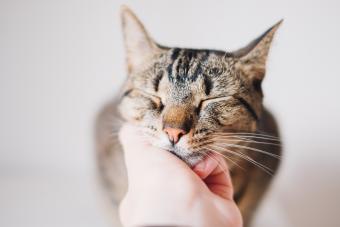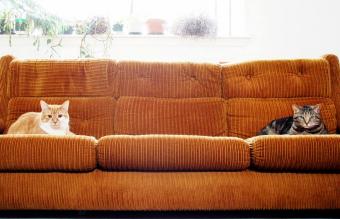
If you're wondering what that meow means, it's helpful to listen to examples of cat sounds and compare. It's fascinating to hear the variations within a kitty's regular meows that can convey a broad array of complex desires and emotions.
Common Cat Sounds
Cats will vocalize their contentment, hostility, and inquiries through mostly different sounds. A 1978 study in Developmental Psychobiology reported that these vocalizations are specific to different circumstances. In other words, similar to how humans may have a different tone of voice to convey annoyance, surprise, or happiness, cats can vocalize their 'feelings' in much the same way through the different sounds that they make.
Murmurs and Purring
Most people associate purring with petting. It is a common scenario for a cat to curl up on its owner's lap and purr during a quality petting. In such cases, purring does indicate contentment. Though the precise mechanism of purring is still somewhat of a mystery, scientists do know that purring is a combination of both the larynx muscle activity and the feline's vocal cords.
A classic example of purring can be seen in this video:
Purring is not always a sign of satisfaction and relaxation. A less commonly known fact is that cats will purr when they are stressed, frightened, or in pain. Cats may also purr when they are nursing kittens or rubbing against the leg of a familiar friend.
The Standard Cat's Meow
Cats almost always meow as a direct means of seeking attention. Very frequently, a cat will meow to indicate a need such as food, water, or a cherished activity. The pitch of a cat's meow varies from cat to cat. It can be high, low, very guttural, or almost chirpy. This has little to do with the breed and is entirely individualized from cat to cat though kittens will often display a higher pitch than their mature counterparts.
The expectant meow of a kitten clamouring for food can be seen in the following video:
Trilling and Chirping
When you hear a cat trilling, this means you have a happy cat! Trilling and chirping are pleasant noises that indicates your cat is relaxed. Some cats may make these noises to get your attention and are associated with something positive your cat wants. It could indicate your cat wants affection, playtime, a brushing, or dinner! You may also see them doing it while looking out your window observing birds and squirrels.
Chattering Cats
Sometimes cats will make a chattering sound when their prey drive is aroused. This usually occurs when your cat spies small prey animals such as mice or birds. He or she may also do it when they see a strange cat enter your yard. This sound indicates frustration and arousal. Your cat may also make this noise during play if you engage their prey drive with chasing toys such as a small furry ball on a fishing wand you swish around.
Cat Howls and Growls
The stereotypical caterwaul and low visceral growl are not typically indications of hostility. Instead, these types of sounds demonstrate sexual desire in cats; females in heat and males who are calling for partnership often make these types of sounds. Such howls can be extremely loud and will also be heard during mating activity. Another common cat mating sound is a scream that the female cat will make during the mating process. Some females will only do it once the process is over and the male uncouples himself from her while others will scream and thrash around during the mating act.
Male Cat in Heat
Male cats do not go into heat the way a female does, but they do respond strongly to the presence of a female cat in heat. An aroused male cat will become much more vocal when it senses the presence of a female in heat. This can include non-stop meowing and crying as the male attempts to get to the female.
The Hostile Hiss
Hissing is almost always a sign of hostility. Though some cats will hiss when playing aggressively, this sound is typically associated with territorial urges and aggression. You should never touch or even approach a hissing cat as this may signal a feline attack.
Hissing can be accompanied by hostile growling as indicated in this video:
Cats who become extremely aggressive during mating or caterwauling may also hiss as a means of outing this aggression. It is also unwise to approach a cat who is experiencing this level of sexual aggression.
Breed Talk
Some cat breeds are known for making more noises than others. Very vocal cats include Maine Coons, Burmese, and Tonkinese. Siamese cats have a reputation for being extremely vocal and will make many noises when happy, excited or frustrated.
Another breed of cat known for "making conversation" is the Singapura.
These Japanese Bobtails are displaying their breed's chatty nature by having their own private discussion:
Biology of Cat Sounds
Small cats differ from large cats such as lions and tigers in the type of vocalizations they emit. As Animal Planet explains, the rigid structure of their voice box and the smaller chest cavity limits the domestic cat's range, but not its ability to use sounds for communication.
Vocalizations are determined by the physical structure of a cat as well as the action of the respiratory system muscles and the acts of inhaling or exhaling. For example, cats meow when exhaling and will purr when both inhaling and exhaling, and this gives each vocalization its own unique sound.
Your Cat's Repertoire
Most cat owners are very well-acquainted with their pet's repertoire of sounds. A cat's ability to communicate the complexities of its existence vocally is a part of what makes owning a feline so fulfilling.







